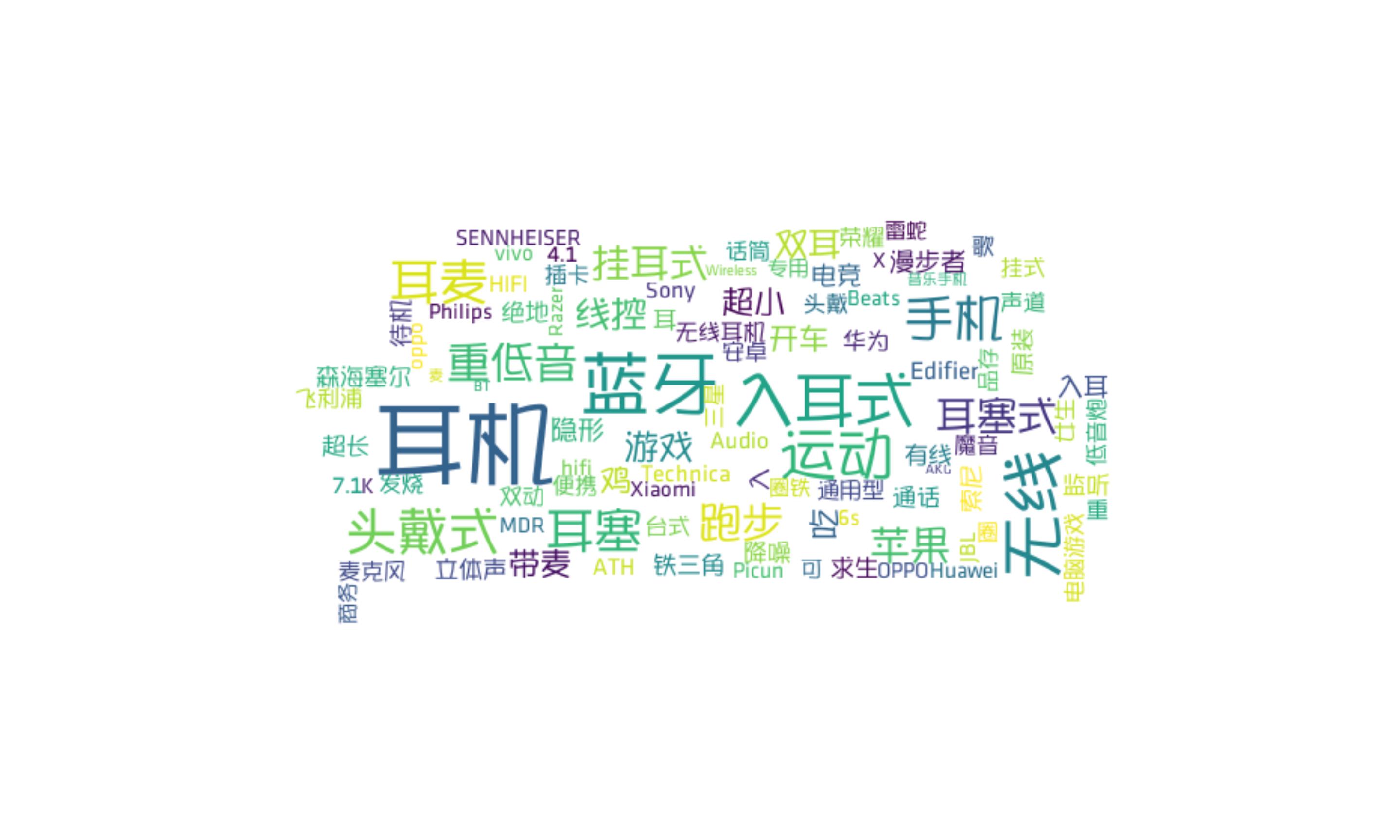Python 002- 爬虫爬取淘宝上耳机的信息
Posted 依然冷月
tags:
篇首语:本文由小常识网(cha138.com)小编为大家整理,主要介绍了Python 002- 爬虫爬取淘宝上耳机的信息相关的知识,希望对你有一定的参考价值。
参照:https://mp.weixin.qq.com/s/gwzym3Za-qQAiEnVP2eYjQ
一般看源码就可以解决问题啦
1 #-*- coding:utf-8 -*- 2 import re 3 import time 4 import requests 5 import pandas as pd 6 from retrying import retry 7 from concurrent.futures import ThreadPoolExecutor 8 9 start = time.clock() #计时-开始 10 11 #plist 为1-100页的URL的编号num 12 plist = [] 13 for i in range(1,101): 14 #淘宝的页数都是以下面这种形式来结束的,所以使用44 15 #https://s.taobao.com/search?q=耳机&xxx&s=44 16 #https://s.taobao.com/search?q=耳机&xxx&s=88 17 j = 44*(i-1) 18 plist.append(j) 19 20 listno = plist 21 datatmsp = pd.DataFrame(columns=[]) 22 23 while True: 24 @retry(stop_max_attempt_number = 8) #设置最大重试次数 25 def network_programming(num): 26 #将耳机转换为汉字编码%E8%80%B3%E6%9C%BA 27 url=\'https://s.taobao.com/search?q=%E8%80%B3%E6%9C%BA&ssid=s5-e \\ 28 &search_type=item&sourceId=tb.index&spm=a21bo.2017.201856-taobao-item.1 \\ 29 &ie=utf8&initiative_id=tbindexz_20170306&fs=1&filter_tianmao=tmall \\ 30 &sort=sale-desc&filter=reserve_price%5B50%2C%5D&bcoffset=0 \\ 31 &p4ppushleft=%2C44&s=\' + str(num) 32 web = requests.get(url, headers=headers) 33 web.encoding = \'utf-8\' 34 return web 35 36 #多线程 37 def multithreading(): 38 number = listno #每次爬取未爬取成功的页 39 event = [] 40 41 with ThreadPoolExecutor(max_workers=10) as executor: 42 for result in executor.map(network_programming, 43 number, chunksize=10): 44 event.append(result) 45 return event 46 47 #隐藏:修改headers参数 48 #因为淘宝可能会出现反爬虫,所以使用cookie,构建head是很有必要的。尽量把自己伪装成一个浏览器。 49 headers = {\'User-Agent\':\'Mozilla/5.0 (Windows NT 10.0; WOW64) \\ 50 AppleWebKit/537.36(KHTML, like Gecko) \\ 51 Chrome/55.0.2883.87 Safari/537.36\'} 52 53 #多线程从json获取数据 54 listpg = [] 55 event = multithreading() 56 for i in event: 57 json = re.findall(\'"auctions":(.*?),"recommendAuctions"\', i.text) 58 if len(json): 59 table = pd.read_json(json[0]) 60 datatmsp = pd.concat([datatmsp,table],axis=0,ignore_index=True) 61 62 pg = re.findall(\'"pageNum":(.*?),"p4pbottom_up"\',i.text)[0] 63 listpg.append(pg) #记入每一次爬取成功的页码 64 65 lists = [] 66 for a in listpg: 67 b = 44*(int(a)-1) 68 lists.append(b) #将爬取成功的页码转为url中的num值 69 70 listn = listno 71 72 #每次循环将爬取失败的数组清空 73 listno = [] #将本次爬取失败的页记入列表中 用于循环爬取 74 for p in listn: 75 if p not in lists: 76 listno.append(p) 77 78 if len(listno) == 0: #当未爬取页数为0时 终止循环! 79 break 80 81 datatmsp.to_excel(\'datatmsp1.xls\', index=False) #导出数据为Excel 82 83 end = time.clock() #计时-结束 84 print ("爬取完成 用时:", end - start,\'s\') 85 86 87 \'\'\' 88 二、数据清洗、处理: (此步骤也可以在Excel中完成 再读入数据) 89 \'\'\' 90 datatmsp = pd.read_excel(\'datatmsp1.xls\') #读取爬取的数据 91 #datatmsp.shape 92 93 # 数据缺失值分析: 94 # 安装模块:pip3 install missingno 95 import missingno as msno 96 msno.bar(datatmsp.sample(len(datatmsp)),figsize=(10,4)) 97 98 # 删除缺失值过半的列 99 half_count = len(datatmsp)/2 100 datatmsp = datatmsp.dropna(thresh = half_count, axis=1) 101 102 # 删除重复行: 103 datatmsp = datatmsp.drop_duplicates() 104 105 \'\'\' 106 说明:只取了 item_loc, raw_title, view_price, view_sales 这4列数据, 107 上面的item_loc, raw_title, view_price, view_sales 都是从网页源代码中获取的标签信息 108 主要对 标题、区域、价格、销量 进行分析,代码如下: 109 \'\'\' 110 # 取出这4列数据: 111 data = datatmsp[[\'item_loc\',\'raw_title\',\'view_price\',\'view_sales\']] 112 data.head() #默认查看前5行数据 113 114 # 对 item_loc 列的省份和城市 进行拆分 得出 province 和 city 两列: 115 # 生成province列: 116 # lambda表达式类似于一个没有声明的函数 117 data[\'province\'] = data.item_loc.apply(lambda x: x.split()[0]) 118 119 # 注:因直辖市的省份和城市相同 这里根据字符长度进行判断: 120 data[\'city\'] = data.item_loc.apply(lambda x: x.split()[0] \\ 121 if len(x) < 4 else x.split()[1]) 122 123 # 提取 view_sales 列中的数字,得到 sales 列: 124 #data[\'sales\'] = data.view_sales.apply(lambda x: x.split(\'人\')[0]) 125 126 # 查看各列数据类型 127 data.dtypes 128 129 # 将数据类型进行转换 130 #data[\'sales\'] = data.sales.astype(\'int\') 131 132 list_col = [\'province\',\'city\'] 133 for i in list_col: 134 data[i] = data[i].astype(\'category\') 135 136 # 删除不用的列: 137 data = data.drop([\'item_loc\',\'view_sales\'], axis=1) 138 139 140 \'\'\' 141 三、数据挖掘与分析: 142 143 【1】. 对 raw_title 列标题进行文本分析: 144 使用结巴分词器,安装模块pip3 install jieba 145 \'\'\' 146 title = data.raw_title.values.tolist() #转为list 147 148 # 对每个标题进行分词: 使用lcut函数 149 import jieba 150 title_s = [] 151 for line in title: 152 title_cut = jieba.lcut(line) 153 title_s.append(title_cut) 154 155 \'\'\' 156 对 title_s(list of list 格式)中的每个list的元素(str)进行过滤 剔除不需要的词语, 157 即 把停用词表stopwords中有的词语都剔除掉: 158 \'\'\' 159 160 # 导入停用词表: 161 stopwords = pd.read_excel(\'stopwords.xlsx\') 162 stopwords = stopwords.stopword.values.tolist() 163 164 # 剔除停用词: 165 title_clean = [] 166 for line in title_s: 167 line_clean = [] 168 for word in line: 169 if word not in stopwords: 170 line_clean.append(word) 171 title_clean.append(line_clean) 172 173 \'\'\' 174 因为下面要统计每个词语的个数,所以 为了准确性 这里对过滤后的数据 title_clean 中的每个list的元素进行去重, 175 即 每个标题被分割后的词语唯一。 176 \'\'\' 177 title_clean_dist = [] 178 for line in title_clean: 179 line_dist = [] 180 for word in line: 181 if word not in line_dist: 182 line_dist.append(word) 183 title_clean_dist.append(line_dist) 184 185 # 将 title_clean_dist 转化为一个list: allwords_clean_dist 186 allwords_clean_dist = [] 187 for line in title_clean_dist: 188 for word in line: 189 allwords_clean_dist.append(word) 190 191 192 # 把列表 allwords_clean_dist 转为数据框: 193 df_allwords_clean_dist = pd.DataFrame({\'allwords\': allwords_clean_dist}) 194 195 196 # 对过滤_去重的词语 进行分类汇总: 197 word_count = df_allwords_clean_dist.allwords.value_counts().reset_index() 198 word_count.columns = [\'word\',\'count\'] #添加列名 199 200 201 \'\'\' 202 观察 word_count 表中的词语,发现jieba默认的词典 无法满足需求: 203 有的词语(如 可拆洗、不可拆洗等)却被cut,这里根据需求对词典加入新词 204 (也可以直接在词典dict.txt里面增删,然后载入修改过的dict.txt) 205 \'\'\' 206 add_words = pd.read_excel(\'add_words.xlsx\') #导入整理好的待添加词语 207 208 # 添加词语: 209 for w in add_words.word: 210 jieba.add_word(w , freq=1000) 211 212 213 #======================================================================= 214 # 注:再将上面的 分词_过滤_去重_汇总 等代码执行一遍,得到新的 word_count表 215 #======================================================================= 216 217 #word_count.to_excel(\'word_count.xlsx\', index=False) #导出数据 218 219 \'\'\' 220 词云可视化: 见下<图2> 221 安装模块 wordcloud 222 方法:pip3 install wordcloud 223 \'\'\' 224 from wordcloud import WordCloud 225 import matplotlib.pyplot as plt 226 from scipy.misc import imread 227 plt.figure(figsize=(20,10)) 228 229 pic = imread("shafa.png") #读取图片,自定义‘沙发’形状 230 w_c = WordCloud(font_path="semplice.ttf",background_color="white", 231 mask=pic, max_font_size=60, margin=1) 232 wc = w_c.fit_words({x[0]:x[1] for x in word_count.head(100).values}) 233 234 plt.imshow(wc, interpolation=\'bilinear\') 235 plt.axis("off") 236 plt.show() 237 238 \'\'\' 239 以上注释: 240 shafa.png 是透明背景图 将该图放在Python的项目路径下! 241 "./data/simhei.ttf" 设置字体 242 background_color 默认是黑色 这里设置成白色 243 head(100) 取前100个词进行可视化! 244 max_font_size 字体最大字号 245 interpolation=\'bilinear\' 图优化 246 "off" 去除边框 247 \'\'\' 248 249 \'\'\' 250 不同省份的商品数量分布: 251 \'\'\' 252 plt.figure(figsize=(8,4)) 253 data.province.value_counts().plot(kind=\'bar\',color=\'purple\') 254 plt.xticks(rotation= 0) 255 plt.xlabel(\'省份\') 256 plt.ylabel(\'数量\') 257 plt.title(\'不同省份的商品数量分布\') 258 plt.show()
得到的结果:

以上是关于Python 002- 爬虫爬取淘宝上耳机的信息的主要内容,如果未能解决你的问题,请参考以下文章